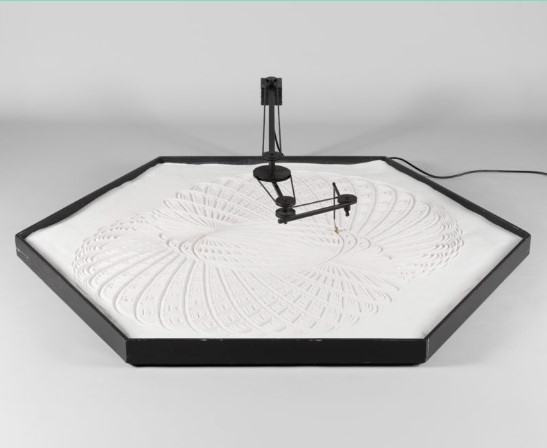The featured works invite you to reflect on how our observations and experiences of reality are influenced by our senses. Osmo Valtonen’s sand plotters Circulografi (1983) and Ellipsografi (1982) measure space and time, drawing geometric shapes that evoke the repeating shapes of the universe. The plotters’ fascinating trajectories and the lines that they slowly inscribe in the sand provide the viewer with an opportunity to sink into timelessness.
The photographs of Carl-Erik Ström and Keiji Uematsu explore human activity as part of nature and a larger context. Ström’s photographs show signs of human presence, of an event and the resulting subtle changes in the landscape. Uematsu’s photo series Landscape (1974) contrasts invisible natural phenomena with an industrial landscape shaped by people. At first glance, the most notable difference between the photographs is the variation of light and shadow in the sky. Maija Luutonen’s extremely reductive acrylic paintings banish all human traces, stripping the image of everything but pure, material perception, hinting at something that can be sensed but not seen.
Anu Pennanen’s video installation A Monument for the Invisible (2003) reveals how it feels to move around the city in an unfamiliar way, relying on senses other than vision. The blind person’s passage from one obstacle to the next, past traffic lights and construction sites, underlines the visual nature of city planning and architecture. Leah Beeferman’s video work The Elements (2019–20) shows different parts of a landscape moving on a plane and slowly transforming towards the abstract. Observations of natural phenomena on our planet combine with similar phenomena that occur far off in space. The work explores how all of our experiences ultimately end up as pictures in our minds.
The artists featured in the exhibition are: Leah Beeferman, Maija Luutonen, Anu Pennanen, Carl-Erik Ström, Keiji Uematsu and Osmo Valtonen.
The exhibition was curated by HAM curators Petronella Grönroos, Arttu Merimaa and Satu Metsola.




